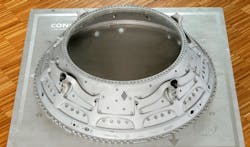AM Technology Takes Up Technical, Commercial Opportunities
The commercial challenge that additive-manufactured parts present to castings would not be so significant without the technical and commercial opportunities that match some of AM’s functional strengths. An example of the first emerged last month when GE Additive revealed a jet engine structure – a part that generally is produced by casting – manufactured in nickel alloy 718 using GE’s Direct Metal Laser Melting process. With its 1-meter diameter, it is among the largest AM parts ever produced for an aerospace application.
It is a turbine center frame (TCF) casing for an aircraft engine, which directs hot gas flowing from a high-pressure turbine into a low-pressure turbine – thus generating engine thrust. This is a part typically produced as a casting and then finish machined, but it carries strict certification requirements, which means that the number of foundries able to produce it are limited and thus long lead-times are common.
The AM version emerged from GE Aerospace’s Turbine Technology Project, set up to accelerate technology maturation for future engines. It was initiated as a response to a call for proposals from the European Commission and aerospace-industry funded Clean Sky 2 program, focused on new aircraft engines and propulsion systems that will process Sustainable Aviation Fuel and promote low-emission commercial aviation.
Multiple academic partners as well as software developer Autodesk joined GE Additive in designing the TCF – and that input was decisive, helping to identify advantages beyond a shorter supply chain. “We wanted to reduce the weight of the part by 25% but also improve the pressure losses of the secondary air flow, as well as (achieve) a strong reduction in part count to improve maintenance,” explained the technology and operations manager for GE Aerospace Advanced Technology, Dr. Günter Wilfert.
GE’s Concept Laser unit’s DMLM process builds parts directly from an .stl file generated from CAD data. The .stl file is converted to a sliced file through GE’s machine software, and then uses a laser to selectively melt alloy powder to form each slice into a thin layer of the design. It’s similar in application to laser-sintering AM techniques, but sintering methods partially melt alloy particles so they adhere to each other; DMLM melts that the material completely “to create ultra-thin liquid pools, which solidify as they cool.”
The result – as demonstrated on GE Additive’s one-meter-diameter, TCF casing – is high surface quality and minimal porosity in the final part. With DMLM, it is possible to move the print bed in increments as small as 20-micron increments, so the results exhibit a smooth surface that minimizes the need for post-production finishing. Along with the weight savings, GE noted this finished part consolidates multiple structural elements, and reduced the lead-time from nine months (for a casting) to two-and-a-half months.
An example of the commercial opportunities for AM to replace castings emerged in October when a Belgian business adopted 3D Systems’ dual-laser DMP Flex 350 direct metal printing technology for contract production of titanium parts, for various industrial and medical device components. Amnovis reportedly has improved its metal AM productivity and reduced production costs, too.3D Systems’ Direct Metal Printing is a laser-sintering/powder-bed fusion process, with a build volume of 275×275×420 mm (10.82×10.82×16.54 in.; W×D×H.) It has a proprietary vacuum chamber for printing reactive materials, such as titanium, in a low-oxygen (<30 ppm) atmosphere with low argon-gas consumption. Single- and dual-laser process configurations are available.
According to the system developer, DMP Flex 350 Dual is effective for printing medical devices, aerospace components, turbomachinery, semiconductors, and automotive/motorsports parts. As for Amnovis’ adoption, the DMP Flex 350 two-laser system is effective for printing critical, high-value parts in volume – enhancing productivity.
Amnovis was an early adopter of laser-based AM for titanium medical devices, like orthopedic and spinal implants. The DMP Flex 350 Dual printer is helping Amnovis to expand its potential for developing stock and patient-specific medical devices – and to introduce product and process enhancements that also may be applicable for aerospace, high-tech, and similarly regulated industrial applications.

